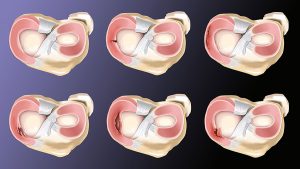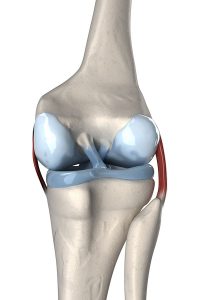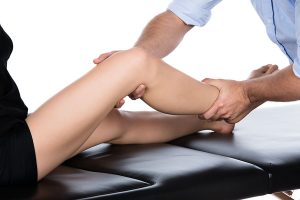A knee meniscus tear or injury occur quite easily, and we see a lot of them. Meniscus tears don’t have to be related to sports only, but can happen to anyone. A sudden twist or jerk can lead to tear your meniscus, which needs rest, recovery, patience, compliance and a lot of rehab. Luckily, we are able to assist you with that. But first, you need to know whether or not you have a meniscus tear. This article will serve to give you all the info and what you need to know about your knee pain.
If your orthopedic surgeon has scheduled surgery – to be more specific, an arthroscopy to ‘clean out the joint. HOLD on, hear us out what you’re in for…
What is the meniscus made up of?
The meniscus is a collagen compound structure made up of rubbery cartilage. It is a C-shaped disc between the Tibia (shin bone) and Femur (thigh bone). The meniscus acts like a cushion to protect the bone, absorb shock and stabilize the joint. Not only does the meniscus serve these purposes, but it also acts as a lubricant in the joint to make the gliding of the Femur onto the Tibia smoother.
Without the meniscus, the bones move on each other and this could cause locking , catching grinding in your knee, not to mention the lack of proper movement in your knee joint. In turn, this leads to a cascade of swelling, pain and dysfunction of your knee joint. Each knee has 2 of these disc, the outer C-shaped part is called the lateral meniscus, and the one on the inside of your knee is called the medial meniscus.
What are the causes of a meniscus injury?
A knee meniscus tear is a common knee injury that occurs when you forcefully twist or rotate your knee. Imagine you are on the soccer field, you are heading in one direction towards the ball at full speed. Suddenly your teammate kicks the ball in the opposite direction and you quickly change your direction of movement. Your foot stays stuck in the ground whilst this change in direction occurs. This movement causes an enormous torsional load on the meniscus and leads to a compression and shearing of the discs, splitting this fragile cushion.
Similarly to this scenario, imagine yourself on the rugby field. You have to do a sudden side step. This sudden change in weight placement under all your weight combined with buckling of your knee to the inside leads to a medial meniscus tear.
What is the rest of the knee made up of?
Your knee joint is made up of mainly four structures, namely: bone, ligaments, cartilage (meniscus), and muscles.
- Bones: Three bones form your knee joint: thigh bone (femur), shinbone (tibia), and kneecap (patella).
- Articular cartilage: At the round part of the femur and tibia bones, and behind the patella, there is a cartilage “covering”, which makes the bones glide easily across each other to ensure smooth bending and straightening of your knee.
- Meniscus: This is also a type of cartilage, more like a disc that distributes forces through your knee. They are wedge shaped and situated on the medial (inside) and lateral (outside) of your tibia bone. The meniscus is there to help absorb shock through the knee joint, to stabilize and cushion impact through the joint.
- Tendons: Muscles connect to bones via tendons. The quadriceps tendon connects the muscles in the front of your thigh (quads) to your patella. The patellar tendon stretches from your patella to your tibia. The hamstring tendons run around the back to bend your knee.
- Muscles: The quads serve as a mobilizing unit to help straighten (extend) your knee. Important here is the VMO muscle – the most inside one of the four quad muscles, due its stability function in the knee. If the VMO doesn’t activate properly, the knee will inevitably be unstable.
So what happens physiologically during a meniscus injury?
As the name suggest its tearing, stripping, split of this essential disc in your knee. There’s classifications for these tears, but what you must understand is that this cushioning discs are vital to keep the bones tracking on each other.
There are different degrees, severity and ways How the meniscus can tear. Grade I meniscus tears happen when the two bones hooking on a part of the cartilage and then shear it off its anchor position. With a Grade I there is no displacement of the meniscus or dislodging of its pieces. There is a physical tear in the cartilage, but everything stays in place. However, this is still very painful and can cause locking and sharp pain in your knee joint only at certain angles.
With any injury to the meniscus greater than a Grade I, the part of the meniscus that tears could even come loose and fold over, doubling and twisting inside the joint split. Some pieces may even tear off their anchor site completely. These loose pieces of cartilage are pinched between the Tibia and the Femur, which causes pain and a locking/stuck feeling deep inside the joint.
Painful angle
You’ll notice there’s a difference between standing on the knee, or when moving it when sitting down. When weight is put through your knee, these discs are compressed. The normal slide and glide action of the Femur on the Tibia is blocked and you will find it very painful to straighten or bend your knee.
Symptoms of a Meniscus tear
Grade I Meniscus tear:
- Pain when standing on one leg
- Difficulty bending and straightening your leg
- Climbing stairs feels like it gets stuck
- Standing up from a chair gives a sharp sting
- Swelling gets worse as you move during the day
- A creaking sensation
- Pain, especially when twisting or rotating your knee
- “Arc”of motion pain: You have pain in certain degrees of movement only (e.g between 30 and 60 degrees)
- Pain climbing stairs (up and especially down)
- Sharp pain when jumping (during push off)
- When kept still the pain is “not so bad” as long as you don’t move it
Grade II/III Meniscus tear:
- Catching or locking almost all the time
- Knee is “stuck”
- Fear of putting your full weight on that leg
- Pain through whole range of movement
- Constant awareness of knee pain
- A lot of Swelling
- Swelling gets worse if you walk on it
- Unable to stand up from a chair without pain
- Can’t bend knee at all
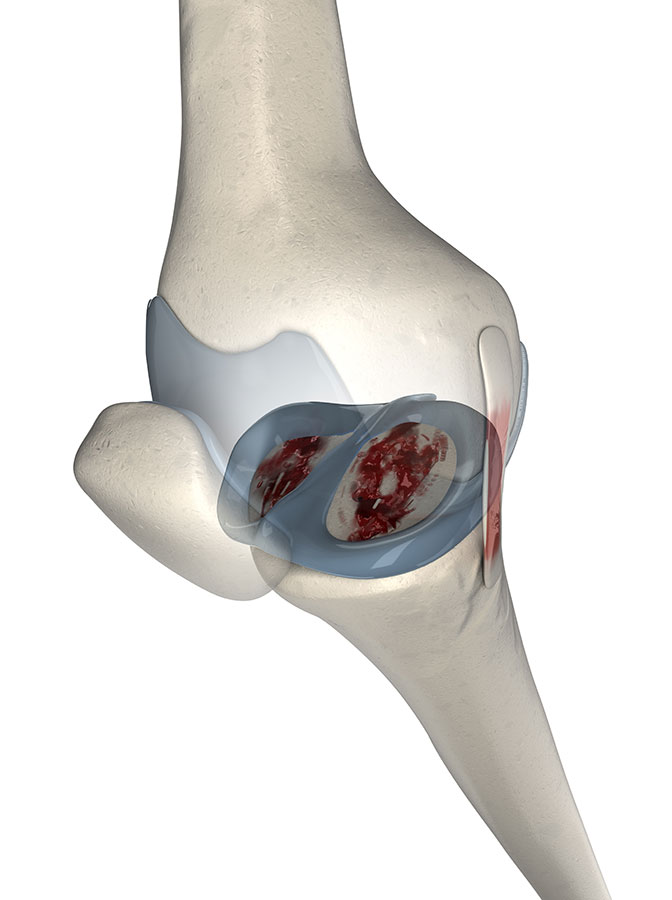
How do we test for a torn meniscus?
Physiotherapist use a range of grueling tests to confirm the extent, degree and which area of your meniscus is torn, but we also test all the surrounding structures – just to be thorough. Within a few minutes we are able to accurately determine if you have a torn meniscus in your knee.
Here’s a few clinical diagnostic test that we perform in our practice to get detail about the severity of your meniscus tear.
- Thesaly’s test
- McMurray’s test
- Stress tests
- Joint line tenderness (JLT)
- Functional testing
- Strength and activation testing of the stability muscles surrounding your knee
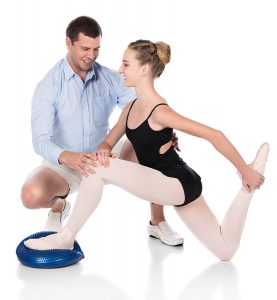
Stability is the main concern
The main concern with a Gr III meniscus tear, is the inability to stabilize the knee joint.
Often there will be no pain, but the disfigurement is quite obvious and there may be swelling. It is important to remember that meniscus injuries dont always occur alone. The ligaments are in close confinement with the meniscus and are very often also involved. Over 50% of all ACL Ruptures have associated Meniscal injuries. If seen in combination with a Medial Meniscus Tear and MCL Injury, it is called O’Donohue’s Triad which has 3 components:
Other diagnostic tools
X-rays
An x-ray will not be necessary to detect a torn meniscus, because x-rays only show the bones. As a meniscus is made up of cartilage, it will not show on an x-ray and will merely be a waste of time and money.
Ultrasound
An ultrasound detects the soft tissue around the joint such as muscles, tendons and fat pads. It may rule our other factors but will not be accurate with detection of a knee meniscus tear. However, if you suspect a torn meniscus, the ultrasound will pick up swelling and fluid collection, which in turn can indicate a possible injury to your meniscus.
MRI
MRI scans are the most accurate and golden standard when it comes to detecting a meniscus tear, especially if we suspect a higher grade tear. However, it is extremely expensive and sometimes redundant. The reason for this is that your physio will be able to accurately detect a meniscus tear through our clinical testing.
Degrees of meniscus tears- how bad is it?
Grade I and II meniscus tear
A grade I or II meniscus tear is a small tear on the outskirts of the meniscus. This type of tear is generally not considered serious and there is no need for surgery, but guiding you through the phases of recovery is essential. There may still be pain, a locking sensation and loss of full range in your knee, but this is quite an easy fix with physiotherapy. We will discuss every stage of treatment shortly and the goals you’ll achieve.
Grade III meniscus tear
A grade III meniscus tear is more serious and can cause long term damage if not managed properly. With a grade III tear, the edges of the meniscus can come loose and fold over inside the knee joint, causing a lot of pain and dysfunction. If you imagine the C-shaped cartilage, you can see that it serves as a “cushion” between the bones to aid in gliding of the joint. Now, if there are pieces coming loose and floating around in the joint or even doubles over, you can imagine the pain and discomfort such an injury can bring. A grade III meniscus tear may require surgery, but please see our updated information below on surgery vs conservative treatment. Rehabilitation is important with or without surgery and it is essential to follow your physiotherapist’s protocol during this time.
Our experience with meniscus tears
We see all sorts of meniscus injuries. From Cyclists unable to unclip their cleats and falling over barriers, to dancers coming down from a jump and landing on a twisted knee. Rugby players doing a sidestep and soccer players changing course of direction while at full speed.
If you start using your knee before the menisci is healed, you could cause the small tears to develop into a very large tear. Patients who have a large untreated tear may be at greater risk of developing compilations and knee arthritis in the long run. We generally want to get our patients back in action, but in the case of a torn meniscus, too much too soon is an accident waiting to happen. If you follow our well researched protocol fully, you will not only get back stronger and faster, but also not be at risk for re-injury.
Why does a Meniscus take such a long time to heal?
The outer portion of the meniscus, often referred to as the “red zone,” has a good blood supply and heals faster. The inner two thirds of the meniscus, known as the “white zone,” does not have a good blood supply, thus slower healing. Tears in this region take much longer to heal due to the lack of blood vessels and sometimes requires surgical reattachment.
Recovery Time:
The estimated time for full recovery will be 6-12 weeks. The wide range depends on the degree of the tear, severity, other structures involved, your compliance with the program.
Swelling is a problem that causes pain
Swelling after any injury is normal, but too much swelling can cause intense constant pain. The swelling in the knee is an accumulation of inflammatory cells that has come to heal the tissue. The greater the damage, the more cells your body will send into your knee. Think of your knee as a blown up water balloon between two rocks. The more cells that enters the knee joint, the more pressure inside your knee. Not to mention the small arteries and veins that rupture and spill blood directly into the knee joint. This increase in pressure inside the knee puts pressure on pain sensitive structures that keeps on overloading your brain with these pain impulses. Hence, the more the swelling, the more the pain.
Physiotherapist Treatment
- Rest the knee
- Use crutches for walking
- No walking on the knee until the pain is completely gone
- Ice your knee for 15-20 minutes every 3-4 hours for 2-3 days to minimize the swelling
- Compress your knee. Use an elastic bandage or a neoprene type sleeve on your knee
- Elevate your knee with a pillow at he back of the knee when lying down
- Take anti-inflammatory medications. Non-steroidal anti-inflammatory drugs (NSAIDs), like Cataflam, K-Fenak, or Myprodol will help with pain and swelling
- Start with slow, pain-free movements in the swimming pool
To use or nor to use anti-inflammatories?
Inflammation is not always a bad thing. It kick-starts the healing process and is an essential part in healing. There is a reason the body produces inflammatory markers when you have injured yourself. However, if this cycle continues for too long, the unnecessary amount of swelling as mentioned above, becomes a problem.
Therefore, we suggest that you do not use anti-inflammatories in the acute phase (the first 48 hours) since the onset of your injury. Let the inflammation “do its job”, but you may start using them after those first 48 hours to aid in the management of pain, swelling and the discomfort inflammation brings along with it.
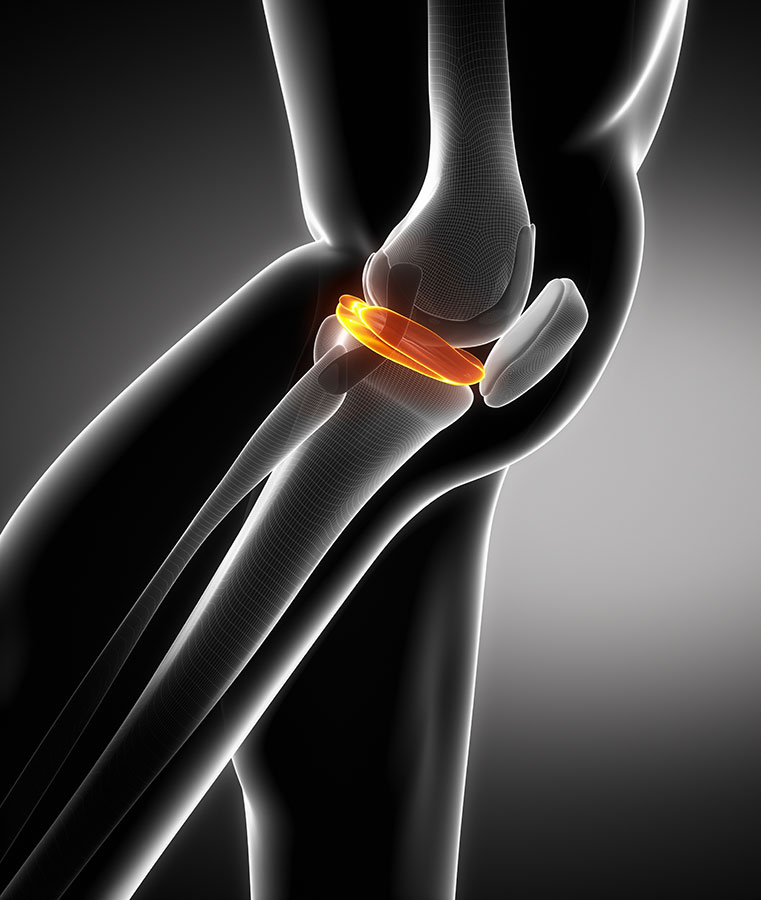
Physiotherapist Treatment and healing time for meniscus tears in stages:
1st Phase: Protection & initial Healing (Day 1 – 2)
We have found that patients tend to continue walking on the injured leg with a limp. The load placed on the meniscus can injure it more. It’s better to get crutches and keep the load off the meniscus. The main concern is to prevent the meniscus from tearing even further.
Rest
No weight on the injured leg. Use crutches to take the load off.
Ice
Ice cubes wrapped in a towel, tied around the knee reduces pain & inflammation and speeds up the healing process.For at least the first 3 days or until the swelling goes down, apply an ice pack for 20 minutes every two hours. Always keep a towel between the ice and your skin (to prevent a cold burn), and press the ice pack firmly.
Compress
Use strapping (Leukotape S) or elastic compression bandage to keep the knee supported and prevent blood pooling in your leg. This can be done either with taping or tube grip bandage and helps to control swelling.
Elevate
Lying on your back with your foot on a chair (your thigh must be higher than your heart to allow gravity to assist in draining the pooled blood in your leg.)Raise your calf for 15 minute intervals during the day.
2nd Phase: Regain Full Range of Movement (Week 1 – 2)
The most important component of rehabilitation is to regain full range of movement in the knee eventually. During week 1-2 however, we have to limit the amount of flexion as to prevent too much load on your meniscus. Here we generally strap your knee into a 60 degree flexion along with NWB (non weight bearing) activities in the crutches.
Also during this phase we use neurodynamic and joint mobilizations to achieve the adequate range of movement.
Pain management is still key during this phase of management. We use Laser, Soft tissue mobilizations and Ultrasound therapies.
3rd Phase: Eccentric Muscle Strength (Week 2 – 3)
A muscle contraction works in two directions: One where the muscle is contracted and it shortens like a leg press (concentric), and controlling the descent going down from a leg press into knee flexion (eccentric). This loads the quad tendon fibers while being lengthening under tension. These type of exercises is vital at conditioning the quad tendon fibers to absorb a force. 90 degrees of flexion allowed in this phase. The reason we want to strengthen your quad at this point is so the knee is stabilized by the use of the muscles surrounding the knee joint. Isometric strengthening and ballistic stretching exercises will also be included in our treatment plan during this time. Specificity and degree of progression of your exercises will be discussed with you in session.
4th Phase: Concentric Muscle Strength (Week 3 – 4)
Shortening of the quads tendon during a contraction involves strength and power exercises that will be progressed gradually as healing takes place. This will be tested frequently to determine if you can progress from non-weight bearing to full weight bearing (walking without crutches). Our physiotherapist will guide and monitor the tendons reaction to normal forces & loading like walking, climbing stairs and driving. By this time you will be doing your functional activities without crutches. Full range of knee motion allowed in this phase.
5th Phase: High Speed, Power, Proprioception (Week 4 – 5)
The knee must be tested under high load and speed to ensure that the muscle, tendons and meniscus will be able to keep up with the demand of your body. During this phase our physiotherapist will guide you to return to normal activities, as well challenge the knee to determine how it reacts to different forces and prepare you to return to participating in your sport.
6th Phase: Sport Specific Training (Week 5 – 6)
Depending on your sport, our physiotherapist will tailor specific exercises that will help strengthen the affected area pertaining to your sport. A successful outcome is when you have gained knowledge throughout the rehabilitation program and can participate at full power and speed, not to mention the benefits of minimizing your chance of future injury.
We aim to correct your biomechanical movement patterns and to improve your speed, skill and agility, hereby possibly helping you to perform even better than before. This is a holistic view, and during this phase it is important to follow through, as we not only prevent re-ocurrence of the injury, but also aim to get you stronger than you were before.
Is surgery really necessary?
We will be able to tell you after your first session.
Conservative treatment vs surgery in meniscus tears
A study done in 2018 by the NCBI showed the following results:
There were no significant differences in the clinical outcomes with patients who underwent surgery vs the patients who only received conservative treatment. The outcomes included pain, range of motion and strength measures. They concluded that the arthroscopic repair was not superior to conservative management and should therefore not be your first choice of treatment in meniscus tears. There is quite a lot of controversy about the management of meniscus tears, especially if we are dealing with a grade III tear. But if you get a proper assessment done in collaboration with your physio and surgeon, you will find the best answer specific for you and your needs. There are always exceptions and therefore it is important to get the best medical advice you can.
What else could your knee pain be?
- Knee cap: Patella dislocations
- Meniscal injuries
- Collateral ligaments injury
- Posterolateral corner of the knee
- Patellar dislocation or fracture
- Femoral, tibial or fibular fractures
- Cruciate ligament injuries (ACL tear or PCL tear)
- Pes anserines bursa
- ITB syndrome (lateral)
- Chondromalacia


